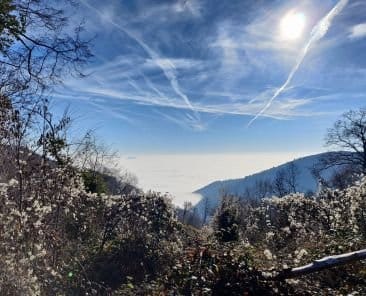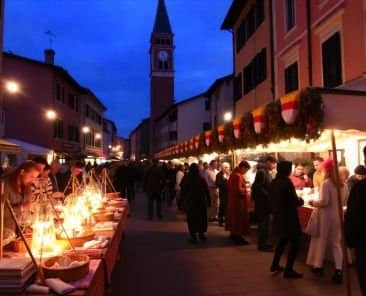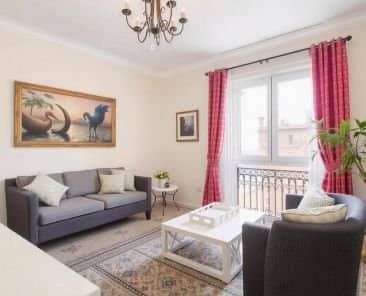There are around 4,500 fancy villas in Veneto, many of which exude an “old-money” aesthetic due to their enchanting architecture and classic countryside feel.
But what’s the story behind such a high concentration of villas in this particular region?
It’s interesting to know that in 1345, investments in agriculture were avoided in the region, as it was believed they could slow down the economy of Venice, the region’s main city. People weren’t allowed to own land outside the city, and inland business activities were forbidden until 1407, when Venice took over Padua, which soon became like a second capital.
Originating in the 15th century, the first Venetian villas were integral components of expansive farming estates with central courtyards and ancillary buildings. Noble families, capitalising on their trade wealth, started to invest in these self-sufficient agricultural complexes and make profits from the land. Later, they built luxury villas along the Brenta River, connecting Venice to Padua.
Perhaps uniquely in Italy, these expansive land estates were not built on defensive positions, like hills, nor were protected by fortifications. This, if nothing else, will give you an idea of the region’s wealth and security at a time when most of Europe was battling with continuous strife.
Venetian villas are easily recognisable by their landmark structure: generally, a master’s house in the centre, surrounded by one or more barchesse, that is, long porches which originally housed agricultural equipment, animals, the farmers’ families. Nowadays, their original purpose no longer exists and many have been turned into modern dwellings. Often, though, they are neglected and in disrepair.
In the 16th century, Andrea Palladio, a well-known Renaissance architect, brought a new way of thinking to Western architecture. Starting out as a stonemason, he learned from studying ancient Roman and Greek buildings and used their style to create a fresh, elegant approach. His work was focused on balance, symmetry, and the use of features like columns and arches. Palladio’s villas, known as Palladian villas, are now protected as part of the UNESCO World Heritage Site, “City of Vicenza and the Palladian Villas of the Veneto.” But his influence didn’t stop in Italy. Famous buildings around the world, such as the White House in Washington, D.C., and St. Paul’s Cathedral in London, took inspiration from Palladio’s ideas.
Today, more than historical buildings from the past, these villas are important cultural elements of the region, open for visitors to experience a feel from the past that still feels alive today.
Our Top Pics of Venetian Villas
We’ve gathered a list of some of the most beautiful Venetian villas we suggest you visit in the future.
Tenuta Ca’ Zen – Venetian Villa in Po Delta
Located in the picturesque Po Delta Regional Park, Tenuta Ca’ Zen is a historic Venetian villa dating back to the 1700s. Originally a shooting lodge owned by the Zen family, this charming estate now offers a unique agriturismo experience under the care of Mrs. Elaine and her daughter, Maria Adelaide Avanzo.
With nine cosy rooms and two independent apartments, guests can enjoy a comfortable stay year-round. They can delight in delicious Po Delta cuisine with reservation-only dinners, explore the surrounding natural beauty with outdoor activities like trekking and biking or simply relax by the romantic swimming pool. Perfect for family holidays or a romantic getaway.
Villa San Fermo – The Convent
Originally built in the 16th century, Villa San Fermo was transformed into a magnificent palace in the 1800s by the noble Contarini family. Today, it’s a UNESCO Heritage Site with a beautiful venue for special events like weddings and corporate gatherings. Although simple, the rooms are comfortable, and you’ll wake up to the sounds of nature, with a 30-hectare park nearby, homemade breakfasts, and the peace of the countryside.
Villa Saranceno
Villa Saraceno is one of Andrea Palladio’s famous villas located in the Veneto region of Italy. Built-in the mid-16th century, it reflects Palladio’s signature style, which is best represented by classical Roman elements with a focus on symmetry and balance. The villa was originally designed as a working farm estate, with its central living quarters connected to agricultural buildings.
What makes Villa Saraceno stand out is its simplicity and elegance. It reflects harmonious spaces without excessive decoration. Today, it is a UNESCO World Heritage Site and is admired for its historical significance and architectural beauty, attracting visitors who appreciate Palladio’s timeless designs.
Villa Valmarana ai Nani
Villa Valmarana ai Nani is a masterpiece composed of three distinct buildings located within a historical park. Dating back to the 17th and 18th centuries, these architectural treasures include the Palazzina, constructed in 1669 as the owners’ residence, and the Foresteria and Scuderia, built in 1720 as guest accommodations and stables, respectively.
Legend has it that the villa derived its name from the 17 stone dwarfs that once adorned its garden, inspiring the fabled tale of Princess Layana. Sculpted by Francesco Uliaco and likely based on drawings by Giandomenico Tiepolo, these statues now grace the walls surrounding the house, adding to the villa’s charm.
Villa Foscari
Villa Foscari, also known as “La Malcontenta,” is a timeless masterpiece designed by Andrea Palladio in the 16th century. As a UNESCO World Heritage site, Villa Foscari remains a private residence, where visiting hours are limited to the public from April to November, Tuesdays through Saturdays, from 9 am to noon. Visitors are required to book their visits online at least 10 days in advance, with an admission fee of ten euros. Architecture enthusiasts might find themselves captivated by the complex details of Palladio’s design, while casual visitors will be fascinated by the beauty of the space.
Villa Contarini
Once a humble farmhouse, Villa Contarini was transformed into a grand palace in the mid-17th century by Marco Contarini, Procurator of St Mark – one of the top government roles in the Republic of Venice. Through the years, it passed through the hands of various owners until the Camerini family purchased and restored it in the 19th century, infusing it with the eclectic style of the time. Today, under the supervision of the G.E. Ghirardi Foundation and the Veneto Region, Villa Contarini serves as a cultural epicentre, where concerts, conferences, and art exhibitions are hosted.
Villa Almerico Capra
Villa Almerico Capra, often referred to as La Rotonda, is another timeless masterpiece designed by Andrea Palladio for Paolo Almerico over 500 years ago. Beyond its architectural significance, La Rotonda has served as a gathering place for poets, artists, monarchs, scholars, and travellers, never failing to impress visitors with its pure beauty and inspiring presence. Designated as a UNESCO World Heritage site since 1994, La Rotonda is celebrated as one of Palladio’s most iconic works, drawing admirers from all around the globe.
The Pros and Cons of Buying a Venetian Villa
Owning a Venetian villa, as depicted in aesthetically pleasing photos that could easily be part of one’s vision board, appears to be a dream within reach, more attainable than one might imagine. There are two main reasons: there are literally hundreds of these villas scattered around, many no longer serving a purpose as farms or leisure estates for wealthy families. And with today’s smaller families not having reason or the budget to restore what are generally immense buildings, they can often be purchased for relatively low sums of money.
However, as with any other significant decision in life, being well-informed in advance about whether purchasing such property it’s worth the investment or not, is the key to avoiding confusion and challenges that naturally accompany the process of purchasing a new property. That being said, here are some pros and cons if you’re considering buying a historic house in the Veneto region.
Pros of Buying a Venetian Villa
Cultural Richness
Owning a piece of one of the richest and grandest cultures in the Western world is a rare privilege bestowed upon few. This provides the “lucky ones” with the unique opportunity to co-exist with the country’s past, beauty and art and connect with them on deeper levels, something that wouldn’t be possible if the villas didn’t hold the authentic value they do.
Architectural Beauty
Historical houses offer an exceptional architectural beauty that is often unmatched by the modern constructions we see nowadays. Such structures, running the gamut from extremely detailed interiors and exteriors, to rural buildings that are more humble in nature but still the product of master masons’ work, sport a beauty that never fades – no matter how the evolution of design changes.
Authentic Living Experience
Owning a historic house allows buyers to completely involve themselves with authentic Italian living. Once outfitted with modern comforts, perfect for those who want to live in their dream home and be comfortable.
Rental Potential
Historic houses, especially those in town centres or picturesque countryside locations, have excellent rental potential. Tourists are drawn to accommodation that offers an authentic Italian experience, making historic properties desirable as holiday rentals.
Connection to Nature
Natural landscapes, including vineyards, olive groves, and rolling hills, often surround these properties. Beyond many retreat opportunities the area has to offer, connecting with nature is one of those simple activities that truly makes a difference and improves the quality of life.
Cons of Buying a Historic House in Italy
Complex Legal Considerations
Historic properties often come with complex legal issues, including multiple generations of ownership and stringent preservation regulations. For this reason, buyers must conduct due diligence to overcome these complexities effectively.
High Renovation Costs
Restoring a historic house to its former glory is a significant financial investment. Renovation costs can quickly escalate, especially for properties requiring extensive structural work or preservation efforts. Furthermore, managing a project of this scale is a daunting task – especially when attempted from afar.
Maintenance Challenges
Historic houses may require ongoing maintenance to preserve their architectural integrity and structural stability. Buyers should be prepared to take on the responsibility of maintaining and caring for these properties over time.
Limited Modern Amenities
While historic houses have their own aesthetic and character, they may lack the modern amenities found in newer homes. Buyers should assess their comfort level with potentially limited amenities such as central heating, air conditioning, or updated electrical wiring. While these amenities can often be retrofitted, they are sometimes impossible or difficult to add because of each property’s particular limitations. Do you want to rip up a 400-year-old stone floor so you can install underfloor heating?
Restrictions on Modifications
To add to this, properties of historical interest may be subject to restrictions on modifications or renovations. Buyers must be aware of these limitations and ensure they are comfortable following the preservation guidelines set forth by local authorities.
Should You Buy a Villa in Veneto?
Deciding whether to purchase a villa in Veneto is a multifaceted choice shaped by personal preferences, lifestyle aspirations, financial circumstances, and the challenges that might come with the process. However, while the effort may pose certain challenges, as mentioned in this article, the incomparable value of such a property exceeds monetary considerations. Indeed, investing in a Veneto villa represents an opportunity to acquire an iconic landmark with the potential for significant future returns, both financial and emotional. Moreover, it affords the rare privilege of being part of Italy’s storied past while remaining connected to its active present, an experience that promises lasting fulfilment. As Frank Gehry once remarked: “Architecture should speak of its time and place, but yearn for timelessness”. And all the Veneto’s historic buildings seem to perfectly embrace this idea!
Was this helpful?
Good job! Please give your positive feedback
How could we improve this post? Please Help us.


















